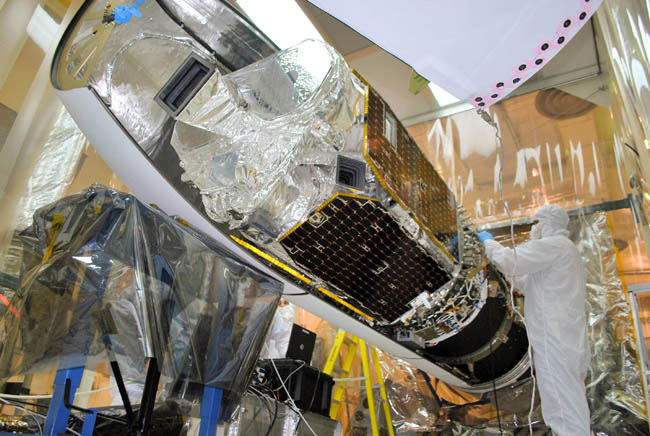
WASHINGTON — NASA’s Nuclear Spectroscopic Telescope Array (NuSTAR) spacecraft, one of only two U.S. astrophysics missions launching ahead of the long-delayed James Webb Space Telescope, has been mated to an air-launched Pegasus XL rocket awaiting integration with the carrier plane that will take it from California to an equatorial launch range in the Pacific Ocean for a June 13 launch.
NuSTAR, an X-ray observatory that will study supermassive black holes, neutron stars, supernova remnants and the sun, was to have launched in mid-March but was delayed for additional testing of the Pegasus rocket’s flight software.
NuSTAR is expected to cost $170 million to build, launch and operate in a near-equatorial orbit for its two-year mission, Yunjin Kim, the NuSTAR project manager at the Jet Propulsion Laboratory in Pasadena, Calif., said May 30 at a press briefing at NASA headquarters here. According to NASA budget documents released in February, the agency expected its total expenditures on NuSTAR to reach $160 million by the end of 2012.
Kim said the delays have added “several million dollars” to NuSTAR’s prelaunch costs.
Dulles, Va.-based Orbital Sciences Corp. built the NuSTAR spacecraft bus for NASA and is providing the Pegasus XL rocket that will take the observatory to orbit. Orbital also operates the L-1011 Stargazer carrier plane that on June 5 will fly NuSTAR from Vandenberg Air Force Base, Calif., to the Ronald Reagan Test Site on the Kwajalein Atoll in the Marshall Islands and ultimately will carry NuSTAR to an altitude of 12,000 meters for launch. NuSTAR is due to arrive in Kwajalein June 6. Launch is targeted for June 13 in the early morning hours local time, Kim said. Backup launch dates are June 14 and June 15.
The last NASA mission launched by a Pegasus XL rocket was the Interstellar Boundary Explorer satellite in 2008. The rocket has had 26 successful launches since its last failure in 1996.
Since the problems with the Pegasus XL flight software surfaced in early March, Orbital engineers have been busy “correlating the simulation environments, running thousands of non-real-time and real-time closed loop simulations, and comparing results with previous Pegasus missions,” Orbital Sciences spokesman Baron Beneski wrote in a May 31 email.
NASA will pass judgment on the modified flight software at NuSTAR’s June 1 flight readiness review, Beneski said.
After NuSTAR reaches orbit, it will begin a weeklong checkout followed by approximately three weeks of instrument calibration before science operations can begin, Kim said.
NuSTAR principal investigator Fiona Harrison of the California Institute of Technology said the telescope, which she proposed as an Explorer-class astrophysics mission in 2003, will be the most sensitive X-ray observatory ever flown. In 2014, senior astrophysicists will review Nu-STAR’s accomplishments and decide whether to recommend funding for an extended mission.
Once NuSTAR is up and running, NASA will have 14 active astrophysics missions, NASA Astrophysics Division Director Paul Hertz said at the May 30 briefing.
Next in NASA’s astrophysics mission queue is the Gravity and Extreme Magnetism Small Explorer X-ray Telescope (GEMS), which will launch in 2014 on a nine-month mission to observe many of the same objects as NuSTAR. NASA expects to spend about $171.1 million to build and launch that mission, according to the latest public budget documents.
NASA astrophysics is also contributing an instrument to the Japanese-built Astro-H X-ray spectroscopy mission, launching in 2014, but GEMS is the last NASA spacecraft that will launch before the budget-busting James Webb Space Telescope flies in 2018. The Webb telescope is an independently managed flagship astrophysics mission and is now expected to cost $8.8 billion to build, launch and operate in space for five years. The cost has put pressure on future NASA astrophysics missions.
Related
ncG1vNJzZmiroJawprrEsKpnm5%2BifHKBkGxpp5mjlnqvwdKtmKtlqGK%2FosWMrKeam5Viwaa4xKyaqKiVYsCmwIyfpqtlmqq7pnmQbGSlmaWjsKl7